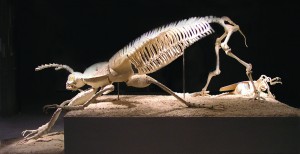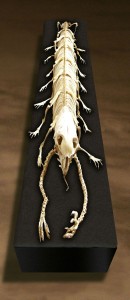Unknown Creature No.2 Cockroach / Unknown Creature No.18 Multiped


Shen Shaomin
Shen Shaomin
http://www.shenshaomin.com
SHEN SHAOMIN, “BONES OF CONTENTION”
John McDonald
Shen Shaomins skeletons of imaginary creatures send one’s thoughts back to the debates generated by Charles Darwin’s ‘dangerous idea’, and forward to the Faustian ambitions of contemporary science. The bones of humans and animals we dig from the earth are the most basic and poignant proofs of existence. They testify to the act of being, and -in the hands of forensic scientists-provide clues as to the physical appearance and properties of the living creature. They do not, however, tell us anything about the mind or the personality that was once contained by that carriage of bones. Science deals in facts and leaves art to provide the imaginative and sentimental elements. It is one of the abiding conceits of Shaomin’s work that the artist mimics the role of the natural scientists. He presents us with a museum of relics that seem, at first glance, to have been excavated by archaeologists. We look upon a skeletal menagerie that has never truly existed, although the bones and bone meal he uses have been drawn from real animals. This gives his creations an uncanny verisimilitude ?they are eerily reminiscent of Dr. Frankenstein’s experiments in stitching together a new life from remnants of the dead.
[…]
Part of the impact of Shaomin’s work comes from his willingness to create strange hybrids between species and to upset conventional expectations about scale. Some of his creatures resemble gigantic insects, in the manner of the bug-eyed monsters of the B-movies, yet they may have elements suggestive of fish or animal forms. The many small pieces in installations such as Experimental Field No.2, are combinations of animal and vegetable, as though small, sharp-clawed creatures were growing from between the leaves of a Chinese cabbage. In another work, the skeletal infants have been nurtured inside cocoons that look like huge pea pods. These clustered sculptures are even more disturbing than the large individual pieces, insofar as they portray a deliberate breeding program, with some anonymous intelligence at work behind the scenes.
There is a warning here about science running out of control, but also a delight in theatrical detail ?in the sense that each piece acts as a prop in some unknown narrative. Shaomin never aims to capture a completely lifelike illusion, in the manner of a sculptor such as Ron Mueck, he shows us only the relics of life. His creatures are not only dead, they have been frozen stiff by some sudden disaster, as bodies were embalmed by volcanic ash during the destruction of Pompeii. He apparently suggests that there are deathly consequences when scientists go wading boldly into the gene pool.
There is a double irony in these works being made by a Chinese artist, because China, of all nations, has had one of the most ruthless attitudes towards the exploitation of the natural world. Mao’s promethean?vision saw Nature as an unruly resource that had to be subdued at all costs, and parts of the country will long suffer the effects of pollution. With the introduction of a market economy, and China’s rapid ascension to the point where it is now the world’s largest industrial consumer of raw materials, there may be much worse to come. It is, perhaps, a further irony that Shaomin makes these works in an old factory in a northern industrial city, playing foreman to a team of assistants.
As China’s industrial and trading might continues to grow, it also continues to send exhibitions of archaeological finds to international museums. Even during the worst days of the Cultural Revolution, Chinese authorities were always ready to conjure up a show of recently-discovered relics, to suggest an ongoing concern with national heritage. In more open and friendly times, these shows have flourished. Many who viewed
Shaomin’s sculptures when shown at Gallery 4a in Sydney, in June 2004, may have seen an exhibition of Chinese dinosaur bones last year at the Australian Museum. It is difficult to know whether one should emphasise the differences between the two shows or the similarities. In one sweeping gesture, Shaomin satirises the overwhelming hubris of science, and the timeless appeal of the touring dinosaur show. He points out where science and popular culture intersect – in our fascination with the skeletons of vanished behemoths and those small but sinister genetic experiments waiting to be born.
